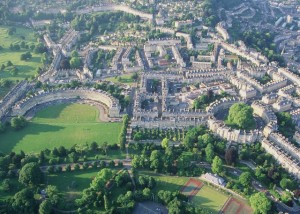This website uses cookies so that we can provide you with the best user experience possible. Cookie information is stored in your browser and performs functions such as recognising you when you return to our website and helping our team to understand which sections of the website you find most interesting and useful.
Overview
When the house was built
No.1 Royal Crescent, Bath (Grade I) was built to the designs of John Wood the Younger in 1767 – 1774 as the first house in the Royal Crescent, a Bath stone crescent of thirty houses with a uniform Palladian design to the principal facade. The Royal Crescent is the culmination of the 18th century development of Bath by the elder and younger John Woods, the latter part-owning No.1. The open view in front of the Royal Crescent, a key element to the design, has been altered by the subsequent development of Bath but partly preserved in the form of what is now Royal Victoria Park and a small semi-circular lawn in the ownership of the Royal Crescent residents. 
The construction of No.1a was carried out in three phases:
(1) 1767: a 2-storey east range was built over cellars;
(2) 1769: an extension of No.1 was built by John Wood the Younger, and
(3) a post-1769 link section was constructed between the two.
The eastern range became the service wing of No.1 and later developments integrated it more fully with No.1.
The house’s occupants over time have altered the original design
The occupation of the house reflects the changing social make-up of Bath with a decline in the status of the occupants from a wealthy landowner (Mr Henry Sandford) who rented the house 1777-1796 to clerics and minor gentry. In the 1840s the house was a seminary for young ladies and later became a lodging-house. There were alterations to the plan and features of the house in the 19th century including the removal of the back stairs and the lowering of all first-floor window sills.
The buildings were first formally separated in 1968, when No. 1 was bought by Mr. Bernard Cayzer who supported its restoration to become both a historic house and the headquarters for the Bath Preservation Trust.
In 2006 No.1a (Grade II) was acquired by the Brownsword Charitable Foundation specifically with the intention of making it available to the Bath Preservation Trust on a long term lease. Preserved within the building are some rare and important kitchen fittings. Reuniting it with No.1 allows the Trust to conserve its significant architecture and fittings, tell the whole story of the house for the first time and improve access.


